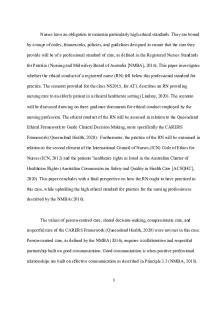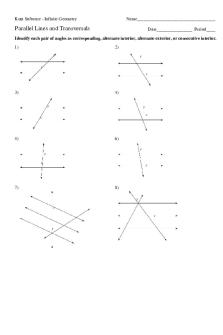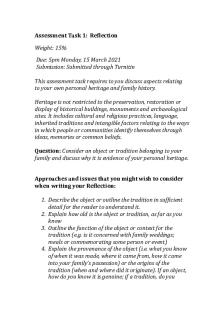JRT2 Task 1 - Parallel Lines Assessment PDF

| Title | JRT2 Task 1 - Parallel Lines Assessment |
|---|---|
| Author | Jill Woodruff |
| Course | Evaluation Methodology and Instrumentation |
| Institution | Western Governors University |
| Pages | 7 |
| File Size | 154 KB |
| File Type | |
| Total Downloads | 66 |
| Total Views | 135 |
Summary
Assessment created for high school geometry parallel lines unit...
Description
JRT2 TASK 1: PARALLEL LINES ASSESSMENT
Task 1
JRT2
Jill Griffitts-Woodruff November 11, 2019
A Written Project Presented to the Faculty of the Teachers College of Western Governors University
JRT2 TASK 1: PARALLEL LINES ASSESSMENT
1
Evaluation Plan The focus of this evaluation is a geometry unit that addresses the relationships within parallel and perpendicular lines. This unit introduces vocabulary related to parallel and perpendicular lines, and uses that vocabulary to describe the unique relationships between parallel lines. Once students have mastered the concepts in this unit, they will be able to apply it to future units. It is imperative that students are successful with this unit because without this foundation knowledge, units that depend on this foundation (such as Quadrilaterals) will be much more difficult. Description of Audience This unit has been designed for an Honors Geometry class. There are 28 students in this class: 17 male and 11 female. Racially, 10 students are African American and 18 identify as White/Caucasian. Two students have IEPs and one has a 504 in place. Two students are 9th grade; the other 26 students are 10th grade. Of the 28 students in this class, 22 successfully completed Honors Algebra 1, two completed CP Algebra 1 (college preparatory), one completed Algebra 1 in Credit Recovery (summer school), and three completed Algebra 1 in a homeschool environment so leveling was not noted. Generally speaking, the previous honors students and homeschoolers work with higher mathematic fluency than those who worked below the honors level last year. They pride themselves on being more academically capable than their friends in other classes.
Type and Purpose of Evaluation This formative evaluation will be conducted for the purpose of determining the effectiveness of the Parallel and Perpendicular Lines unit and identifying areas that require improvement. The South Carolina College and Career Ready Mathematical Process Standards require the concepts in
JRT2 TASK 1: PARALLEL LINES ASSESSMENT
2
this unit, which will ultimately depend upon mastery of this unit. By ensuring students have a solid understanding of this unit, future units will be easier to grasp. Because this unit is so critical to each student’s success in the course, it is important that the effectiveness of this unit is maximized. Evaluation Questions In an effort to improve the existing unit, the following formative evaluation questions have been developed: 1. How could the materials (activities, PowerPoint notes, practice problems, homework assignments) be improved for the Parallel and Perpendicular Lines unit? 2. Which aspects of the Parallel and Perpendicular Lines unit were not given enough emphasis? 3. Which aspects of the Parallel and Perpendicular Lines unit were given too much emphasis? 4. How could the Parallel and Perpendicular Lines unit be made more interactive or kinesthetic for students? 5. Which instructions for the Parallel and Perpendicular Lines unit were unclear?
Potential Interview Purpose of Interview This interview will be conducted for the purpose of improving the materials and pacing for the Parallel and Perpendicular Lines unit and incorporating more interactive and kinesthetic activities within the unit to make it more developmentally appropriate. The interview questions are designed to specifically address each of these areas.
JRT2 TASK 1: PARALLEL LINES ASSESSMENT
3
Respondents As the math department head and senior member of the Gray Collegiate Academy math department, I will conduct the interview. The interview will be conducted by asking questions of three math instructors who are currently teaching at Gray Collegiate Academy. One instructor has a bachelor’s degree in mathematics education, the other two have completed master’s degrees in mathematics. They have all taught this unit during previous years, and will all be teaching it to their students this school year so they all have an appropriate level of familiarity with the unit.
Interview Questions In an effort to improve the existing unit, the following interview questions have been developed: 1. How could the activities be improved for the Parallel and Perpendicular Lines unit? 2. Recommended Homework: a. How should the quantity and time requirement be adjusted? b. Which of the key concepts are not adequately reflected? 3. Bell Ringer Problems: a. How should the quantity and time requirement be adjusted? b. How could they more effectively introduce the day’s concepts? 4. Exit Slip Problems a. How should the quantity and time requirement be adjusted? b. How could they be adjusted to allow students to demonstrate mastery more efficiently or effectively? 5. How could the PowerPoint Notes be improved for this unit?
JRT2 TASK 1: PARALLEL LINES ASSESSMENT
4
6. Which aspects of the Parallel and Perpendicular Lines unit were not given enough emphasis? Which aspects of the Parallel and Perpendicular Lines unit were given too much emphasis? 7. How should the pacing of the unit be adjusted? 8. How could the Parallel and Perpendicular Lines unit be made more interactive or kinesthetic for students? 9. Which instructions for the Parallel and Perpendicular Lines unit were unclear? What revisions can you suggest?
Type of Interview The interview questions were specifically designed to assist with improving each aspect of the Parallel and Perpendicular Lines unit, including bell ringers, lecture notes, exit slips, and homework assignments. One goal of this revised unit is to incorporate more interactive, kinesthetic activities into the lessons, so it was important to ask respondents how they would improve that aspect of the unit as well. The interview was framed in a semi-structured format. It was imperative to ask the respondents about each of the topics, and this open-ended presentation was conducive to the rich, creative contributions of ideas. An unstructured interview format was not chosen because it would not ensure that each area of interest would be addressed. An unstructured interview does not allow for the directional guidance through the inquiry and makes it difficult to ensure thorough responses to each question. Closed, yes/no responses would not provide information that was as comprehensive and thorough as the open-ended questions elicited, therefore they were avoided.
JRT2 TASK 1: PARALLEL LINES ASSESSMENT
5
Potential Questionnaire/Survey The overall purpose of the potential questionnaire is to evaluate the effectiveness and efficiency of the Parallel and Perpendicular Lines unit. The teachers who have implemented the unit will be asked to participate as respondents of this questionnaire. The goal is to have them share their opinions of the effectiveness and efficiency of the unit based on their classroom implementation, as well as their suggestions for future improvements. The questionnaire for the evaluation of this unit has been included in the Appendix.
JRT2 TASK 1: PARALLEL LINES ASSESSMENT
6
APPENDIX Parallel and Perpendicular Lines Unit Questionnaire Please respond to the following questions for the purpose of improving the Parallel and Perpendicular Lines unit. Your opinions and insights are very valuable and appreciated in this process.
1. Were the unit materials (bell ringers, PowerPoint notes, guided notes, exit slips, homework) effective? Which were most effective? Which were least effective? What do you feel would improve the materials?
2. Did the students’ guided notes align well with the daily lectures and PowerPoint notes? How would you improve upon these?
3. Did the exit slip material provide adequate insight into the accomplishments and struggles of the students each day? How would you improve upon these?
4. Did the homework material allow students to practice what was covered in class each day? What changes would you recommend to make the homework more effective?
5. In terms of engagement, were there enough opportunities for interactive or kinesthetic activities in the lessons? In what ways could you incorporate more hands-on engagement?
6. Was the pacing of this unit appropriate? Which aspects needed more time? Which needed less?...
Similar Free PDFs

JRT2-Task 1 WGU
- 8 Pages

D Parallel and Perpendicular Lines
- 10 Pages

BSBPMG522 Assessment Task 1
- 9 Pages

Assessment TASK 1 – Scenario
- 5 Pages

Assessment Task 1
- 2 Pages

Reflection Assessment Task 1
- 4 Pages

NS2015 Assessment Task 1
- 7 Pages

Assessment Task
- 3 Pages

Bsbcrt 412 - Assessment Task 1
- 5 Pages

Bsbcmm 511 - Assessment Task 1
- 14 Pages
Popular Institutions
- Tinajero National High School - Annex
- Politeknik Caltex Riau
- Yokohama City University
- SGT University
- University of Al-Qadisiyah
- Divine Word College of Vigan
- Techniek College Rotterdam
- Universidade de Santiago
- Universiti Teknologi MARA Cawangan Johor Kampus Pasir Gudang
- Poltekkes Kemenkes Yogyakarta
- Baguio City National High School
- Colegio san marcos
- preparatoria uno
- Centro de Bachillerato Tecnológico Industrial y de Servicios No. 107
- Dalian Maritime University
- Quang Trung Secondary School
- Colegio Tecnológico en Informática
- Corporación Regional de Educación Superior
- Grupo CEDVA
- Dar Al Uloom University
- Centro de Estudios Preuniversitarios de la Universidad Nacional de Ingeniería
- 上智大学
- Aakash International School, Nuna Majara
- San Felipe Neri Catholic School
- Kang Chiao International School - New Taipei City
- Misamis Occidental National High School
- Institución Educativa Escuela Normal Juan Ladrilleros
- Kolehiyo ng Pantukan
- Batanes State College
- Instituto Continental
- Sekolah Menengah Kejuruan Kesehatan Kaltara (Tarakan)
- Colegio de La Inmaculada Concepcion - Cebu





